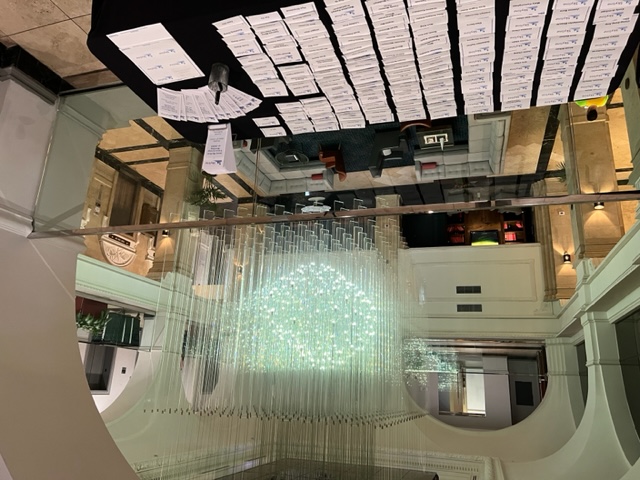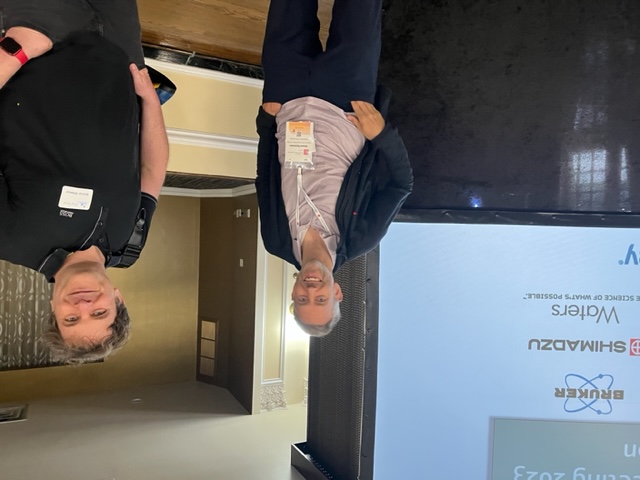Table of Contents |
guest 2025-10-29 |
Event Information
Speakers
Michael MacCoss
Brendan MacLean
Abigail Burrows
Ellen Casavant
Jeroen Demmers
Gunnar Dittmar
Tom Lin
Philip Remes
Julia Robbins
Eduard Sabido
Ariana Shannon
Gary Siuzdak
Stoyan Stoychev
Thanks!
Thanks to everyone who joined us in Houston for the Skyline User Group Meeting before ASMS 2023. It was great to meet with all of you passion Skyline users and share the tremendous opportunity to hear terrific and varied presentations about recent work enabled by Skyline software!
Below are links to the speakers' pages with options to view their slides or watch their presentations. At the bottom of this page, you will also find some photos from the event.
Thanks especially to all the wonderful speakers who volunteered their time and effort to share great presentations ranging from Skyline workflows to the lemons-to-lemonade experience of a destroyed science lab, and much more!
We hope these presentations long outlast the event itself, as previous years have.
Thank you! -- Brendan MacLean and Mike MacCoss, Event hosts
Speakers
Michael J. MacCoss, Ph.D. (University of Washington): Introduction and event host
Brendan MacLean (MacCoss Lab, University of Washington): Status of the Skyline open-source software project 15 years after its inception [video]
The Skyline project started just after ASMS 2008 as a 2-year effort to bring better SRM/MRM software tools to the NCI-CPTAC Verification Working Group that could support the variety of mass spectrometers in use in participating laboratories. Nearly 15 years later, the Skyline project is a thriving proteomics community open-source collaboration supporting 6 mass spec instrument vendors, integrated with a wide variety of external software, with thousands of users worldwide and many thousands of instances started each week. (More info...)
Abigail Burrows Franco Ph.D., (University of Kentucky): Efficient generation of highly multiplexed serum biomarker panels using gas phase fractionation and DIA libraries [video]
Data Independent Acquisition (DIA) methods have become an attractive alternative to traditional Data Dependent Acquisition (DDA) methods for quantitative proteomics and biomarker identification. Here, we describe a novel DIA methodology for evaluating the equine proteome. Detectable peptides can serve as biomarkers for equine medicine to diagnose health conditions, monitor disease progression, and detect performance-enhancing drugs in anti-doping efforts. Typically, DDA-based spectrum libraries are required prior to DIA data analysis. (More info...)
Philip Remes Ph.D., (Thermo Fisher Scientific): A Skyline Tool for Creating Robust Large Scale Targeted MS/MS Assays [video]
Targeted MS/MS is the gold standard for quantitative quality in proteomics but is not widely utilized for large assays (1000’s of targets), because of the manual work involved in setting up the experiment, maintaining the retention time schedule, and analyzing the results. We created a Skyline External tool that automates the tedious parts and makes large scale targeted MS/MS a competitive option to Data Independent Acquisition (DIA) for some situations. (More info...)
Julia Robbins, (Talus Bio): How sweet it is: Leveraging the nuclear envelope glycome for the automated extraction of proteins from cell nuclei [video]
Protein localization within the subcellular environment influences their structure and function. One example is the transcription factor (TF) protein class, which commonly reside in the cytosol prior to being activated, typically by post-translational modification, and then translocating to the nucleus where they interact with DNA and other regulatory proteins to initiate transcription of genes. However, studying TFs is difficult because the process of isolating nuclei is a low-throughput, manual process, and existing bead-based approaches are not selective for nuclei. (More info...)
Stoyan Stoychev Ph.D., (Evosep and ReSyn Biosciences): Mag-Net: Bead based capture of membrane particles from plasma enables liquid biopsy measurements for >4,500 proteins [video]
The robust quantitative characterization of proteins from plasma is critical to the diagnosis of disease and therapeutic monitoring. Membrane-bound particles in plasma are composed of extracellular vesicles, exosomes, and apoptotic bodies and represent ~1-2% of the total protein composition. Analysis of this enriched membrane particle fraction by mass spectrometry is effectively a “liquid biopsy,” and significantly improves the dynamic range of the proteins measurable in plasma. (More info...)
Gary Siuzdak Ph.D., (The Scripps Research Institute): METLIN Ion Mobility: How to Analyze a Million Molecular Standards and Stay Sane [video]
The new METLIN Ion Mobility database has now been created having just completed the analysis of 30,000 molecular standards. METLIN Ion Mobility is an ongoing effort of the METLIN Tandem Mass Spectrometry database with over one million molecular standards analyzed, representing a challenging endeavor, especially when it needs to be accomplished at multiple collisional energies and in both positive and negative ionization modes. (More info...)
Lightning Talks
Ellen Casavant, Ph.D., (Genetech): AutoQC enables efficient and reproducible LC-MS/MS chromatography and instrumentation [video]
Mass spectrometry based proteomics is one approach to identifying and quantifying proteins from biological samples. In the Translational Medicine team at Genentech, discovery and targeted proteomics are performed on clinical samples to discover or quantify proteins relevant to therapeutic treatment or disease progression. To acquire high confidence data that can assist in therapeutic pipeline decision making, consistent evaluation of system suitability is imperative. (More info...)
Gunnar Dittmar Ph.D., (Luxembourg Institute of Health): Quantification of 782 Plasma Peptides by Multiplexed Targeted Proteomics [video]
Blood analysis is one of the foundations of clinical diagnostics. In recent years the analysis of proteins in blood samples by mass spectrometry has taken a jump forward in terms of sensitivity and the number of identified proteins. The recent development of parallel reaction monitoring with parallel accumulation and serial fragmentation (prm-PASEF) combines ion mobility as an additional separation dimension. This increases the proteome coverage while allowing the use of shorter chromatographic gradients. (More info...)
Jeroen Demmers Ph.D., (Erasmus MC Proteomics): Targeted mass spectrometry reveals that USP7 regulates the ncPRC1 Polycomb axis [video]
Ubiquitin-specific protease 7 (USP7) is a deubiquitylating enzyme that is involved in the regulation of multiple key cellular processes, including tumor suppression, transcription, epigenetics, the DNA damage response, and DNA replication. Whereas the role of USP7 in the p53 pathway is well established, a full picture of the USP7 regulatory network is lacking. For example, USP7 has been connected to the Polycomb system, but the molecular mechanism through which USP7 regulates Polycomb functions remains unclear. For debiquitinating enzymes, the regulatory mode of action is at the posttranslational level and, thus, proteomics tools are indispensable to study this. Here, we took an unbiased multi-omics approach with a strong targeted quantitative proteomics component to define the core USP7 network. (More info...)
Tom Lin Ph.D., (Washington University in St. Louis): An Unbiased Proteomics Method to Discover Posttranslational Arginylation Sites from Whole Proteomes [video]
Posttranslational arginylation installed on proteins by arginyltransferase (ATE1) is a critical modification for mammalian cellular homeostasis and development. Absence of this modification in ATE1 knockout mice was embryonically lethal with various signs of cardiovascular defects. Proteomic profiling of arginylation sites is extremely difficult since mass spectrometry cannot distinguish the same mass of translational and posttranslational arginine (+156 Da), and arginylated proteins go through Arg/N-degron pathway for ubiquitin-mediated degradation. Existing methods have proposed plausible arginylation sites on a handful of proteins (More info...)
Eduard Sabido Ph.D., (Center for Genomics Regulation and the University Pompeu Fabra): High-collision energy data-independent acquisition enables targeted and discovery identification of modified ribonucleotides by mass spectrometry [video]
Over 170 post-transcriptional RNA modifications have been described and are common in all kingdoms of life. These modifications range from methylation to complex chemical structures, with methylation being the most abundant. RNA modifications play a key role in RNA folding and function and their dysregulation in humans has been linked to several diseases such as cancer, metabolic diseases or neurological disorder. Nowadays, liquid chromatography-tandem mass spectrometry is considered the gold standard method for the identification and quantification of these modifications due to its sensitivity and accuracy. However, the analysis of modified ribonucleosides by mass spectrometry is complex due to the presence of positional isomers. (More info...)
Ariana Shannon, (Ohio State University): Generating fit-for-purpose targeted assays from a catalog of pre-screened peptides using data-independent acquisition (DIA) based figures of merit [video]
The National Cancer Institute's Clinical Proteomic Tumor Analysis Consortium (CPTAC) classifies proteomics studies in three tiers, where targeted assays are typically Tier-1 (clinical) or Tier-2 (non-clinical), and global studies are Tier-3. Tier-2 targeted proteomics assays using parallel reaction monitoring (PRM) are developed by assessing figures-of-merit (such as limit of quantification) with stable isotope labeled (SIL) peptides and refining or re-selecting those targets through iterative experiments. This process is expensive and time consuming as SIL peptides must be purchased prior to validation. (More info...)
 |
|
 |
|
 |
|
 |
Event Information
Welcome
The Skyline Team is pleased to announce this year's big event, the Twelfth Annual Skyline User Group Meeting, which will be held in Houston, TX on Sunday afternoon before ASMS. We love seeing you all in-person -- so be sure to register and attend! We would like to thank the event sponsors (see below) for their generosity and interest in collaborating with the Skyline project on exciting new targeted and quantitative mass spectrometry techniques.
--Brendan
When: Sunday, June 4, 2023
12:00 - 1:00 pm : Lunch served
1:00 - 2:30 pm : Presentations
2:30 - 3:00 pm : Snacks and break-out discussions
3:00 - 4:30 pm : Presentations
Where: Crystal Ballroom at the Rice 909 Texas Avenue, Houston, TX 77002 (map)
- From the Convention Center, head northeast on Avenida De Las Americas toward Mc Kinney
- Turn left onto Walker St
- Walk seven blocks and turn right onto Main Street
- Walk three blocks and turn left onto Texas Street
- Crystal Ballroom at the Rice (909 Texas Avenue) is on the right in 1/2 block
Here are transportation options in downtown Houston.
[registration closed]
We have closed down our registration process but you can still attend! Please just come to Crystal Ballroom at the Rice 909 Texas Avenue for "day of" registration.
Scheduled Speakers
Michael J. MacCoss, Ph.D. (University of Washington): Introduction and event host
Brendan MacLean (MacCoss Lab, University of Washington): Status of the Skyline open-source software project 15 years after its inception
The Skyline project started just after ASMS 2008 as a 2-year effort to bring better SRM/MRM software tools to the NCI-CPTAC Verification Working Group that could support the variety of mass spectrometers in use in participating laboratories. Nearly 15 years later, the Skyline project is a thriving proteomics community open-source collaboration supporting 6 mass spec instrument vendors, integrated with a wide variety of external software, with thousands of users worldwide and many thousands of instances started each week. (More info...)
Abigail Burrows Franco Ph.D., (University of Kentucky): Efficient generation of highly multiplexed serum biomarker panels using gas phase fractionation and DIA libraries
Data Independent Acquisition (DIA) methods have become an attractive alternative to traditional Data Dependent Acquisition (DDA) methods for quantitative proteomics and biomarker identification. Here, we describe a novel DIA methodology for evaluating the equine proteome. Detectable peptides can serve as biomarkers for equine medicine to diagnose health conditions, monitor disease progression, and detect performance-enhancing drugs in anti-doping efforts. Typically, DDA-based spectrum libraries are required prior to DIA data analysis. (More info...)
Philip Remes Ph.D., (Thermo Fisher Scientific): A Skyline Tool for Creating Robust Large Scale Targeted MS/MS Assays
Targeted MS/MS is the gold standard for quantitative quality in proteomics but is not widely utilized for large assays (1000’s of targets), because of the manual work involved in setting up the experiment, maintaining the retention time schedule, and analyzing the results. We created a Skyline External tool that automates the tedious parts and makes large scale targeted MS/MS a competitive option to Data Independent Acquisition (DIA) for some situations. (More info...)
Julia Robbins, (Talus Bio): How sweet it is: Leveraging the nuclear envelope glycome for the automated extraction of proteins from cell nuclei
Protein localization within the subcellular environment influences their structure and function. One example is the transcription factor (TF) protein class, which commonly reside in the cytosol prior to being activated, typically by post-translational modification, and then translocating to the nucleus where they interact with DNA and other regulatory proteins to initiate transcription of genes. However, studying TFs is difficult because the process of isolating nuclei is a low-throughput, manual process, and existing bead-based approaches are not selective for nuclei.
(More info...)
Stoyan Stoychev Ph.D., (Evosep and ReSyn Biosciences): Mag-Net: Bead based capture of membrane particles from plasma enables liquid biopsy measurements for >4,500 proteins
The robust quantitative characterization of proteins from plasma is critical to the diagnosis of disease and therapeutic monitoring. Membrane-bound particles in plasma are composed of extracellular vesicles, exosomes, and apoptotic bodies and represent ~1-2% of the total protein composition. Analysis of this enriched membrane particle fraction by mass spectrometry is effectively a “liquid biopsy,” and significantly improves the dynamic range of the proteins measurable in plasma. (More info...)
Gary Siuzdak Ph.D., (The Scripps Research Institute): METLIN Ion Mobility: How to Analyze a Million Molecular Standards and Stay Sane
The new METLIN Ion Mobility database has now been created having just completed the analysis of 30,000 molecular standards. METLIN Ion Mobility is an ongoing effort of the METLIN Tandem Mass Spectrometry database with over one million molecular standards analyzed, representing a challenging endeavor, especially when it needs to be accomplished at multiple collisional energies and in both positive and negative ionization modes.
(More info...)
Lightning Talks
Ellen Casavant, Ph.D., (Genetech): AutoQC enables efficient and reproducible LC-MS/MS chromatography and instrumentation
Mass spectrometry based proteomics is one approach to identifying and quantifying proteins
from biological samples. In the Translational Medicine team at Genentech, discovery and
targeted proteomics are performed on clinical samples to discover or quantify proteins relevant
to therapeutic treatment or disease progression. To acquire high confidence data that can assist
in therapeutic pipeline decision making, consistent evaluation of system suitability is imperative.
(More info...)
Gunnar Dittmar Ph.D., (Luxembourg Institute of Health): Quantification of 782 Plasma Peptides by Multiplexed Targeted Proteomics
Blood analysis is one of the foundations of clinical diagnostics. In recent years the analysis of proteins in blood samples by mass spectrometry has taken a jump forward in terms of sensitivity and the number of identified proteins. The recent development of parallel reaction monitoring with parallel accumulation and serial fragmentation (prm-PASEF) combines ion mobility as an additional separation dimension. This increases the proteome coverage while allowing the use of shorter chromatographic gradients.
(More info...)
Jeroen Demmers Ph.D., (Erasmus MC Proteomics): Targeted mass spectrometry reveals that USP7 regulates the ncPRC1 Polycomb axis
Ubiquitin-specific protease 7 (USP7) is a deubiquitylating enzyme that is involved in the regulation of multiple key cellular processes, including tumor suppression, transcription, epigenetics, the DNA damage response, and DNA replication. Whereas the role of USP7 in the p53 pathway is well established, a full picture of the USP7 regulatory network is lacking. For example, USP7 has been connected to the Polycomb system, but the molecular mechanism through which USP7 regulates Polycomb functions remains unclear. For debiquitinating enzymes, the regulatory mode of action is at the posttranslational level and, thus, proteomics tools are indispensable to study this. Here, we took an unbiased multi-omics approach with a strong targeted quantitative proteomics component to define the core USP7 network.
(More info...)
Tom Lin Ph.D., (Washington University in St. Louis): An Unbiased Proteomics Method to Discover Posttranslational Arginylation Sites from Whole Proteomes
Posttranslational arginylation installed on proteins by arginyltransferase (ATE1) is a critical modification for mammalian cellular homeostasis and development. Absence of this modification in ATE1 knockout mice was embryonically lethal with various signs of cardiovascular defects. Proteomic profiling of arginylation sites is extremely difficult since mass spectrometry cannot distinguish the same mass of translational and posttranslational arginine (+156 Da), and arginylated proteins go through Arg/N-degron pathway for ubiquitin-mediated degradation. Existing methods have proposed plausible arginylation sites on a handful of proteins (<20), most of which have not been further validated or functionally investigated. Therefore, protein arginylation remains an understudied field.
(More info...)
Eduard Sabido Ph.D., (Center for Genomics Regulation and the University Pompeu Fabra): High-collision energy data-independent acquisition enables targeted and discovery identification of modified ribonucleotides by mass spectrometry
Over 170 post-transcriptional RNA modifications have been described and are common in all kingdoms of life. These modifications range from methylation to complex chemical structures, with methylation being the most abundant. RNA modifications play a key role in RNA folding and function and their dysregulation in humans has been linked to several diseases such as cancer, metabolic diseases or neurological disorder. Nowadays, liquid chromatography-tandem mass spectrometry is considered the gold standard method for the identification and quantification of these modifications due to its sensitivity and accuracy. However, the analysis of modified ribonucleosides by mass spectrometry is complex due to the presence of positional isomers.
(More info...)
Ariana Shannon, (Ohio State University): Generating fit-for-purpose targeted assays from a catalog of pre-screened peptides using data-independent acquisition (DIA) based figures of merit
The National Cancer Institute's Clinical Proteomic Tumor Analysis Consortium (CPTAC) classifies proteomics studies in three tiers, where targeted assays are typically Tier-1 (clinical) or Tier-2 (non-clinical), and global studies are Tier-3. Tier-2 targeted proteomics assays using parallel reaction monitoring (PRM) are developed by assessing figures-of-merit (such as limit of quantification) with stable isotope labeled (SIL) peptides and refining or re-selecting those targets through iterative experiments. This process is expensive and time consuming as SIL peptides must be purchased prior to validation.
(More info...)
Sponsors
 |
 |
 |
 |
 |
 |
 | |
Speakers
Here are biographies and abstracts for this year's speakers -- each users of Skyline -- scheduled to speak at the Skyline User Group Meeting at ASMS 2023 in Houston, TX.
Michael MacCoss
 |
Michael MacCoss Mike became interested in biomedical applications of mass spectrometry while working in Dr. Patrick Griffin’s protein mass spectrometry lab at Merck Research Laboratories. He obtained a Ph.D. with Professor Dwight Matthews and pursued a postdoc with Professor John R. Yates III. In 2004 he started the MacCoss lab at the University of Washington and it became obvious that while mass spectrometry data could be collected quickly and robustly, the lack of computational tools for the visualization and analysis of these data was a stumbling block. In 2008 he hired Brendan MacLean with the goal of developing professional quality software tools for quantitative proteomics. Mike has worked closely with the Skyline development team and our outstanding group of laboratory scientists and collaborators to ensure that our software uses analytical approaches that have been thoroughly vetted by the mass spectrometry community. |
Brendan MacLean
 Brendan MacLean worked at Microsoft for 8 years in the 1990s where he was a lead developer and development manager for the Visual C++/Developer Studio Project. Since leaving Microsoft, Brendan has been the Vice President of Engineering for Westside Corporation, Director of Engineering for BEA Systems, Inc., Sr. Software Engineer at the Fred Hutchinson Cancer Research Center, and a founding partner of LabKey Software. In this last position he was one of the key programmers responsible for the Computational Proteomics Analysis System (CPAS), made significant contributions to the development of X!Tandem and the Trans Proteomic Pipeline, and created the LabKey Enterprise Pipeline. Since that time, he has worked as a Sr. Software Engineer within the MacCoss lab and led all aspects of design, development and support in creating the Skyline Targeted Mass Spectrometry Environment and its growing worldwide user community.
Brendan MacLean worked at Microsoft for 8 years in the 1990s where he was a lead developer and development manager for the Visual C++/Developer Studio Project. Since leaving Microsoft, Brendan has been the Vice President of Engineering for Westside Corporation, Director of Engineering for BEA Systems, Inc., Sr. Software Engineer at the Fred Hutchinson Cancer Research Center, and a founding partner of LabKey Software. In this last position he was one of the key programmers responsible for the Computational Proteomics Analysis System (CPAS), made significant contributions to the development of X!Tandem and the Trans Proteomic Pipeline, and created the LabKey Enterprise Pipeline. Since that time, he has worked as a Sr. Software Engineer within the MacCoss lab and led all aspects of design, development and support in creating the Skyline Targeted Mass Spectrometry Environment and its growing worldwide user community.
Status of the Skyline open-source software project 15 years after its inception
The Skyline project started just after ASMS 2008 as a 2-year effort to bring better SRM/MRM software tools to the NCI-CPTAC Verification Working Group that could support the variety of mass spectrometers in use in participating laboratories. Nearly 15 years later, the Skyline project is a thriving mass spectrometry community open-source collaboration supporting 6 mass spec instrument vendors, integrated with a wide variety of external software, with many thousands of users worldwide and over ten thousand instances started each week. Read More- Supporting new upstream processing pipelines
- Supporting new instrument acquisition methods
- Enhanced visualizations to better understand input data
- Growth in the Skyline software ecosystem for targeted MS (Skyline, Skyline Batch, AutoQC, Panorama, and External Tools)
- Strong industry support from instrument vendors
- Courses, workshops, webinars and other efforts to create instructional resources for the Skyline community
[PDF]
Abigail Burrows
 Abigail Burrows Franco, Ph.D., obtained her PhD from the University of Nebraska – Lincoln in 2020 and completed her post-doctoral studies at the University of Kentucky under the guidance of Dr. Scott Stanley. During her post-doctoral training, Dr. Burrows Franco was tasked with identifying peptide and protein biomarkers in equine athletes in response to drug administration. This work was in support of the Equine Biological Passport research program. Currently, she is a staff scientist continuing to develop the Equine Biological Passport within Dr. Stanley’s research lab and also serves as the services director of the Research Mass Spec core facility at the University of Kentucky.
Abigail Burrows Franco, Ph.D., obtained her PhD from the University of Nebraska – Lincoln in 2020 and completed her post-doctoral studies at the University of Kentucky under the guidance of Dr. Scott Stanley. During her post-doctoral training, Dr. Burrows Franco was tasked with identifying peptide and protein biomarkers in equine athletes in response to drug administration. This work was in support of the Equine Biological Passport research program. Currently, she is a staff scientist continuing to develop the Equine Biological Passport within Dr. Stanley’s research lab and also serves as the services director of the Research Mass Spec core facility at the University of Kentucky.
Efficient generation of highly multiplexed serum biomarker panels using gas phase fractionation and DIA libraries
Data Independent Acquisition (DIA) methods have become an attractive alternative to traditional Data Dependent Acquisition (DDA) methods for quantitative proteomics and biomarker identification. Here, we describe a novel DIA methodology for evaluating the equine proteome. Detectable peptides can serve as biomarkers for equine medicine to diagnose health conditions, monitor disease progression, and detect performance-enhancing drugs in anti-doping efforts. Typically, DDA-based spectrum libraries are required prior to DIA data analysis. However, we generated a chromatogram library using narrow-window gas phase fractionation (GPF) DIA without previously generating a spectral library. Our primary aim was to develop a routine DIA method for identification of peptide biomarkers in healthy horses. Ultimately, this method will be implemented to establish baseline measurements of equine biomarker peptides. Serum (n=20) were collected from a population of healthy horses. Sera were pooled and tryptically digested using the Thermo Scientific EasyPep Maxi MS Sample Prep Kit. Prepared digests were analyzed on a high-resolution accurate mass coupled to a nano-liquid chromatography system. Six narrow-window GPFs with staggered windows were analyzed from 400-1000 m/z by 100 Da windows and 4 Da scan ranges (Pino et al., 2020). Digested peptides (500 ng) were separated over a 65-minute gradient. Collected DIA data were analyzed against a predicted peptide library (Prosit DB, EncyclopeDIA). Data were analyzed in Skyline (22.2.0.351) and peptides were filtered for suitability as routine biomarker peptides. Peptides were confirmed in a wide-window DIA method (400-1000 m/z; 12 Da). Read More[PDF]
Ellen Casavant
 Ellen Casavant, Ph.D., is a Senior Scientist in the Biomarker Mass Spectrometry team within the
department of Translational Medicine (TM) at Genentech. The biomarker mass spectrometry
team aims to develop mass spectrometry data acquisition methods and analytical techniques to
support measurement of clinically relevant candidate biomarkers from large clinical cohorts to
help inform drug development decision making. As a part of this group, she leads a
computational team that is developing a semi-qualified data-independent acquisition mass
spectrometry pipeline that can enable efficient processing and QC of DIA-MS datasets. Dr.
Casavant has developed a DIA-MS serial dilution method to help understand and establish a
quantitative range within a set matrix (Casavant et al, 2023). She is particularly interested in
developing a fecal proteomics technique to help to identify non-invasive biomarkers to evaluate
mechanism of action for candidate IBD therapeutics and to ease endoscopy burden on patients
suffering from this disease.
Ellen Casavant, Ph.D., is a Senior Scientist in the Biomarker Mass Spectrometry team within the
department of Translational Medicine (TM) at Genentech. The biomarker mass spectrometry
team aims to develop mass spectrometry data acquisition methods and analytical techniques to
support measurement of clinically relevant candidate biomarkers from large clinical cohorts to
help inform drug development decision making. As a part of this group, she leads a
computational team that is developing a semi-qualified data-independent acquisition mass
spectrometry pipeline that can enable efficient processing and QC of DIA-MS datasets. Dr.
Casavant has developed a DIA-MS serial dilution method to help understand and establish a
quantitative range within a set matrix (Casavant et al, 2023). She is particularly interested in
developing a fecal proteomics technique to help to identify non-invasive biomarkers to evaluate
mechanism of action for candidate IBD therapeutics and to ease endoscopy burden on patients
suffering from this disease.
AutoQC enables efficient and reproducible LC-MS/MS chromatography and instrumentation
Mass spectrometry based proteomics is one approach to identifying and quantifying proteins from biological samples. In the Translational Medicine team at Genentech, discovery and targeted proteomics are performed on clinical samples to discover or quantify proteins relevant to therapeutic treatment or disease progression. To acquire high confidence data that can assist in therapeutic pipeline decision making, consistent evaluation of system suitability is imperative. AutoQC, which leverages both panorama and skyline, enables users to monitor the performance of both triple quadrupole and orbitrap instruments through visual assessment of retention drift, mass error shift, peak shape, and many other attributes. From this ongoing monitoring and collection of data, troubleshooting is faster and quantitation is more reproducible over time. More features from AutoQC are currently being implemented to further assist with instrument troubleshooting and performance, including the ability to monitor every sample run on the instrument in order to assess instrument performance during sample collection. AutoQC has now been implemented on all instruments in our laboratory and has helped to quantify and visualize instrument performance in an automated way that improves efficiency of our workflows.[PDF]
Jeroen Demmers
 Jeroen Demmers, Ph.D. studied Chemistry at Utrecht University (the Netherlands). He earned his PhD degree from the same university in 2002, working on the development of tools to study transmembrane peptide and proteins interactions with phospholipid bilayers using hydrogen-deuterium exchange and electrospray ionization mass spectrometry in the groups of Albert Heck and Antoinette Killian. As a postdoctoral fellow in the lab of Brian Chait at The Rockefeller University (New York) he worked on a project involving the proteomic identification of plasmid DNA binding proteins in yeast. In 2005, Jeroen moved to Erasmus University Medical Center to set up a proteomics lab and core facility and to initiate a research program in the field of protein mass spectrometry. Currently, he is an associate professor and director of the Erasmus MC proteomics core facility (www.proteomicscenter.nl). Research in his lab focuses on the molecular mechanisms of the ubiquitin–proteasome system and the lab develops quantitative proteomics technologies for the analysis of protein posttranslational modifications. The Demmers lab collaborates with many research groups within the institute and abroad on various topics, such as protein-protein interactions, immunopeptidomics, targeted proteomics, etc.
Jeroen’s mission is to advocate the superiority of targeted proteomics in terms of specificity, quantitative accuracy, and – arguably – sensitivity over immunoblotting for the quantitative analysis of target proteins in complex biological mixtures. Although one currently still needs a dedicated mass spectrometry facility with skilled personnel and therefore higher initial costs, with the pace of technology development it is likely that small, user-friendly bench-top mass spectrometry equipment will democratize targeted proteomics assays soon. In addition, to push this transformation, the proteomics community should actively show the life science community what advantages it can bring.
Jeroen Demmers, Ph.D. studied Chemistry at Utrecht University (the Netherlands). He earned his PhD degree from the same university in 2002, working on the development of tools to study transmembrane peptide and proteins interactions with phospholipid bilayers using hydrogen-deuterium exchange and electrospray ionization mass spectrometry in the groups of Albert Heck and Antoinette Killian. As a postdoctoral fellow in the lab of Brian Chait at The Rockefeller University (New York) he worked on a project involving the proteomic identification of plasmid DNA binding proteins in yeast. In 2005, Jeroen moved to Erasmus University Medical Center to set up a proteomics lab and core facility and to initiate a research program in the field of protein mass spectrometry. Currently, he is an associate professor and director of the Erasmus MC proteomics core facility (www.proteomicscenter.nl). Research in his lab focuses on the molecular mechanisms of the ubiquitin–proteasome system and the lab develops quantitative proteomics technologies for the analysis of protein posttranslational modifications. The Demmers lab collaborates with many research groups within the institute and abroad on various topics, such as protein-protein interactions, immunopeptidomics, targeted proteomics, etc.
Jeroen’s mission is to advocate the superiority of targeted proteomics in terms of specificity, quantitative accuracy, and – arguably – sensitivity over immunoblotting for the quantitative analysis of target proteins in complex biological mixtures. Although one currently still needs a dedicated mass spectrometry facility with skilled personnel and therefore higher initial costs, with the pace of technology development it is likely that small, user-friendly bench-top mass spectrometry equipment will democratize targeted proteomics assays soon. In addition, to push this transformation, the proteomics community should actively show the life science community what advantages it can bring.
Targeted mass spectrometry reveals that USP7 regulates the ncPRC1 Polycomb axis
INTRODUCTION: Ubiquitin-specific protease 7 (USP7) is a deubiquitylating enzyme that is involved in the regulation of multiple key cellular processes, including tumor suppression, transcription, epigenetics, the DNA damage response, and DNA replication. Whereas the role of USP7 in the p53 pathway is well established, a full picture of the USP7 regulatory network is lacking. For example, USP7 has been connected to the Polycomb system, but the molecular mechanism through which USP7 regulates Polycomb functions remains unclear. For debiquitinating enzymes, the regulatory mode of action is at the posttranslational level and, thus, proteomics tools are indispensable to study this. Here, we took an unbiased multi-omics approach with a strong targeted quantitative proteomics component to define the core USP7 network. METHODS: Relevant knock-outs, including Dox inducible USP7, were generated in HAP-1, DLD1 and U2OS cell lines. We performed interactomics and in-depth global proteomics to identify the USP7 interaction network. Targeted proteomics using parallel reaction monitoring (PRM) was done to accurately quantify all relevant players of the Polycomb system in a label free manner. For targeted proteomics a PRM regime on an Orbitrap Eclipse Tribrid was used to select for sets of previously selected peptides. Targeted proteomics data were analyzed with the Skyline software suite. Read More[PDF]
Gunnar Dittmar
 Gunnar Dittmar, Ph.D. is the group leader of the proteomics of cellular signalling research group at the Luxembourg Institute of Health. After finishing his PhD at the University of Heidelberg, he joined the Lab of Dan Finley at Harvard Medical school as a post-doc. After finishing my Post-Doc, he joined the Max-Delbrück Center for molecular medicine in Berlin as a group leader, starting my own group. At the Delbrück Center, he set up the mass spectrometry core facility, and later he also set up the proteomics core facility at the newly founded Berlin Institute of Health. In 2016 he joined the Luxembourg Institute of Health, where he is still leading the proteomics of cellular signalling group. In parallel, he created the genomic sequencing centre, LuxGen, a joined high throughput sequencing facility and the quantitative biology unit, a technology focused department covering FACS, MRI, Bioinformatics, a reverse protein array and a proteomics platform besides several research groups.
Gunnar Dittmar, Ph.D. is the group leader of the proteomics of cellular signalling research group at the Luxembourg Institute of Health. After finishing his PhD at the University of Heidelberg, he joined the Lab of Dan Finley at Harvard Medical school as a post-doc. After finishing my Post-Doc, he joined the Max-Delbrück Center for molecular medicine in Berlin as a group leader, starting my own group. At the Delbrück Center, he set up the mass spectrometry core facility, and later he also set up the proteomics core facility at the newly founded Berlin Institute of Health. In 2016 he joined the Luxembourg Institute of Health, where he is still leading the proteomics of cellular signalling group. In parallel, he created the genomic sequencing centre, LuxGen, a joined high throughput sequencing facility and the quantitative biology unit, a technology focused department covering FACS, MRI, Bioinformatics, a reverse protein array and a proteomics platform besides several research groups.
Quantification of 782 Plasma Peptides by Multiplexed Targeted Proteomics
Blood analysis is one of the foundations of clinical diagnostics. In recent years the analysis of proteins in blood samples by mass spectrometry has taken a jump forward in terms of sensitivity and the number of identified proteins. The recent development of parallel reaction monitoring with parallel accumulation and serial fragmentation (prm-PASEF) combines ion mobility as an additional separation dimension. This increases the proteome coverage while allowing the use of shorter chromatographic gradients. Read More[PDF]
Tom Lin
 Tom Lin, Ph.D., got his B.S. in Pharmacy in 2009 from Zhengzhou University, M.S. in Bioanalytical Technology in 2012 from Peking University, and Ph.D. in Medicinal Chemistry in 2017 from University of Tennessee HSC. He has been a postdoc for 4 years in Megan Matthews group at University of Pennsylvania working on protein-hydrazine covalent chemistry using Activity-based Protein Profiling (ABPP). Since 2021, he has been a Staff Scientist in Benjamin Garcia lab at Washington University in St. Louis working on discovery and biological functions of posttranslational arginylation.
Tom Lin, Ph.D., got his B.S. in Pharmacy in 2009 from Zhengzhou University, M.S. in Bioanalytical Technology in 2012 from Peking University, and Ph.D. in Medicinal Chemistry in 2017 from University of Tennessee HSC. He has been a postdoc for 4 years in Megan Matthews group at University of Pennsylvania working on protein-hydrazine covalent chemistry using Activity-based Protein Profiling (ABPP). Since 2021, he has been a Staff Scientist in Benjamin Garcia lab at Washington University in St. Louis working on discovery and biological functions of posttranslational arginylation.
An Unbiased Proteomics Method to Discover Posttranslational Arginylation Sites from Whole Proteomes
Posttranslational arginylation installed on proteins by arginyltransferase (ATE1) is a critical modification for mammalian cellular homeostasis and development. Absence of this modification in ATE1 knockout mice was embryonically lethal with various signs of cardiovascular defects. Proteomic profiling of arginylation sites is extremely difficult since mass spectrometry cannot distinguish the same mass of translational and posttranslational arginine (+156 Da), and arginylated proteins go through Arg/N-degron pathway for ubiquitin-mediated degradation. Existing methods have proposed plausible arginylation sites on a handful of proteins (<20), most of which have not been further validated or functionally investigated. Therefore, protein arginylation remains an understudied field. Read More[PDF]
Philip Remes
 Philip Remes, Ph.D., is a senior research scientist in the R&D department of Thermo Fisher Scientific in San Jose, California. He received his Ph.D. in Gary Glish’s lab at the University of Chapel Hill, North Carolina, where he worked on quadrupole ion trap and mass filter instrumentation. At Thermo, he worked with Jae Schwartz on instrument control software, ion trap analyzers, detectors and simulations for the LTQ Velos platform. Later he did similar work as a part of Mike Senko’s Tribrid development team on the Fusion, Lumos, and Eclipse projects. In recent years, Philip has continued working on ion trap technology, branching out to learn about applications and get first-hand experience in how they can benefit from improvements in hardware, instrument control, signal processing, and informatics.
Philip Remes, Ph.D., is a senior research scientist in the R&D department of Thermo Fisher Scientific in San Jose, California. He received his Ph.D. in Gary Glish’s lab at the University of Chapel Hill, North Carolina, where he worked on quadrupole ion trap and mass filter instrumentation. At Thermo, he worked with Jae Schwartz on instrument control software, ion trap analyzers, detectors and simulations for the LTQ Velos platform. Later he did similar work as a part of Mike Senko’s Tribrid development team on the Fusion, Lumos, and Eclipse projects. In recent years, Philip has continued working on ion trap technology, branching out to learn about applications and get first-hand experience in how they can benefit from improvements in hardware, instrument control, signal processing, and informatics.
A Skyline Tool for Creating Robust Large Scale Targeted MS/MS Assays
Targeted MS/MS is the gold standard for quantitative quality in proteomics but is not widely utilized for large assays (1000’s of targets), because of the manual work involved in setting up the experiment, maintaining the retention time schedule, and analyzing the results. We created a Skyline External tool that automates the tedious parts and makes large scale targeted MS/MS a competitive option to Data Independent Acquisition (DIA) for some situations. Read More[PDF]
Julia Robbins
 Julia Robbins is a senior research associate at Talus Bio with five years of experience in mass spectrometry proteomics. Her research focuses on methods development for high-throughput proteomics sample preparation, and she has particular interest in bead-based automation. When she’s not orchestrating multiple robots and instruments in the lab, she’s a doting plant mom and dabbles in scientific illustration.
Julia Robbins is a senior research associate at Talus Bio with five years of experience in mass spectrometry proteomics. Her research focuses on methods development for high-throughput proteomics sample preparation, and she has particular interest in bead-based automation. When she’s not orchestrating multiple robots and instruments in the lab, she’s a doting plant mom and dabbles in scientific illustration.
How sweet it is: Leveraging the nuclear envelope glycome for the automated extraction of proteins from cell nuclei
Protein localization within the subcellular environment influences their structure and function. One example is the transcription factor (TF) protein class, which commonly reside in the cytosol prior to being activated, typically by post-translational modification, and then translocating to the nucleus where they interact with DNA and other regulatory proteins to initiate transcription of genes. However, studying TFs is difficult because the process of isolating nuclei is a low-throughput, manual process, and existing bead-based approaches are not selective for nuclei. Read More[PDF]
Eduard Sabido
 Eduard Sabido, Ph.D., is the head of the Proteomics Unit of the Center for Genomics Regulation and the University Pompeu Fabra. His group is part of the Spanish Infrastructure for Omics Technologies (ICTS OmicsTech) and his research interests are focused on the development of innovative mass spectrometry methods for targeted protein quantification and data analysis, and recently, on the characterization of nucleoside modifications in biological samples.
Eduard Sabido, Ph.D., is the head of the Proteomics Unit of the Center for Genomics Regulation and the University Pompeu Fabra. His group is part of the Spanish Infrastructure for Omics Technologies (ICTS OmicsTech) and his research interests are focused on the development of innovative mass spectrometry methods for targeted protein quantification and data analysis, and recently, on the characterization of nucleoside modifications in biological samples.
High-collision energy data-independent acquisition enables targeted and discovery identification of modified ribonucleotides by mass spectrometry
Over 170 post-transcriptional RNA modifications have been described and are common in all kingdoms of life. These modifications range from methylation to complex chemical structures, with methylation being the most abundant. RNA modifications play a key role in RNA folding and function and their dysregulation in humans has been linked to several diseases such as cancer, metabolic diseases or neurological disorder. Nowadays, liquid chromatography-tandem mass spectrometry is considered the gold standard method for the identification and quantification of these modifications due to its sensitivity and accuracy. However, the analysis of modified ribonucleosides by mass spectrometry is complex due to the presence of positional isomers. Read More[PDF]
Ariana Shannon
 Ariana Shannon is a fourth-year pre-doctoral graduate student within the Ohio State Biochemistry Program. In 2019 she joined the lab of Dr. Amanda Hummon, while using DIA to study tumor-stromal interactions within 3D cell-based tumor cocultures models. In 2022, she began to additionally work with Dr. Brian Searle developing methods to characterize immunological assays with targeted and global mass-spectrometry based proteomics.
Ariana Shannon is a fourth-year pre-doctoral graduate student within the Ohio State Biochemistry Program. In 2019 she joined the lab of Dr. Amanda Hummon, while using DIA to study tumor-stromal interactions within 3D cell-based tumor cocultures models. In 2022, she began to additionally work with Dr. Brian Searle developing methods to characterize immunological assays with targeted and global mass-spectrometry based proteomics.
Generating fit-for-purpose targeted assays from a catalog of pre-screened peptides using data-independent acquisition (DIA) based figures of merit
Introduction: The National Cancer Institute's Clinical Proteomic Tumor Analysis Consortium (CPTAC) classifies proteomics studies in three tiers, where targeted assays are typically Tier-1 (clinical) or Tier-2 (non-clinical), and global studies are Tier-3. Tier-2 targeted proteomics assays using parallel reaction monitoring (PRM) are developed by assessing figures-of-merit (such as limit of quantification) with stable isotope labeled (SIL) peptides and refining or re-selecting those targets through iterative experiments. This process is expensive and time consuming as SIL peptides must be purchased prior to validation. Read More[PDF]
Gary Siuzdak
 Gary Siuzdak, Ph.D., is Professor and Director of the Scripps Center for Metabolomics at The Scripps Research Institute. He is an affiliate scientist at the Lawrence Berkeley National Lab and has served as Vice President of the American Society for Mass Spectrometry. His research includes developing novel technologies for metabolomics, metabolite imaging and systems biology. He has over 300 peer-reviewed publications and two books including the "The Expanding Role of Mass Spectrometry in Biotechnology”. Other information can be found at https://en.wikipedia.org/wiki/Gary_Siuzdak
Gary Siuzdak, Ph.D., is Professor and Director of the Scripps Center for Metabolomics at The Scripps Research Institute. He is an affiliate scientist at the Lawrence Berkeley National Lab and has served as Vice President of the American Society for Mass Spectrometry. His research includes developing novel technologies for metabolomics, metabolite imaging and systems biology. He has over 300 peer-reviewed publications and two books including the "The Expanding Role of Mass Spectrometry in Biotechnology”. Other information can be found at https://en.wikipedia.org/wiki/Gary_Siuzdak
METLIN Ion Mobility (downloadable): How to Analyze a Million Molecular Standards and Stay Sane
The new METLIN Ion Mobility database has now been created having just completed the analysis of 30,000 molecular standards. METLIN Ion Mobility is an ongoing effort of the METLIN Tandem Mass Spectrometry database with over one million molecular standards analyzed, representing a challenging endeavor, especially when it needs to be accomplished at multiple collisional energies and in both positive and negative ionization modes. Read More[PDF]
Stoyan Stoychev
 Stoyan Stoychev, Ph.D., Stoyan has a background in Structural Biology and experience in the field of biological mass spectrometry having worked at a core facility for over 15 years. He currently holds a joint position at Evosep and ReSyn Biosciences with main focus on developing end-to-end (sample to to mass spectrometer) solutions for routine proteome profiling.
Stoyan Stoychev, Ph.D., Stoyan has a background in Structural Biology and experience in the field of biological mass spectrometry having worked at a core facility for over 15 years. He currently holds a joint position at Evosep and ReSyn Biosciences with main focus on developing end-to-end (sample to to mass spectrometer) solutions for routine proteome profiling.
Mag-Net: Bead based capture of membrane particles from plasma enables liquid biopsy measurements for >4,500 proteins
The robust quantitative characterization of proteins from plasma is critical to the diagnosis of disease and therapeutic monitoring. Membrane-bound particles in plasma are composed of extracellular vesicles, exosomes, and apoptotic bodies and represent ~1-2% of the total protein composition. Analysis of this enriched membrane particle fraction by mass spectrometry is effectively a “liquid biopsy,” and significantly improves the dynamic range of the proteins measurable in plasma. We have developed a one-step enrichment strategy (Mag-Net) using strong-anion exchange magnetic microparticles (ReSyn Biosciences) to capture membrane-bound particles from plasma. The Mag-Net method is robust, reproducible, hemolysis compatible, inexpensive, and requires <100 μL plasma input. Coupled to a quantitative liquid chromatography mass spectrometry strategy using data independent acquisition, we demonstrate that we can routinely collect results for >42,000 peptides from >4,500 plasma proteins with high precision. Read More[PDF]